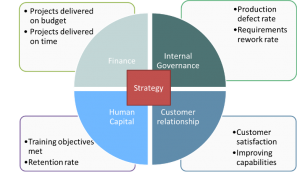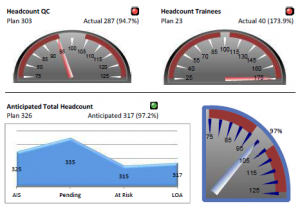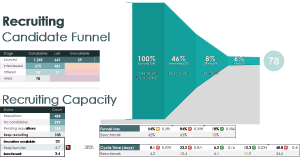Human Capital Management Capabilities
Actionable Strategies combines the best practices of Human Capital Management with the progressive approaches of high growth organizations. We have successfully fostered innovation in large multi-nationals, fostered agility in formerly slow-moving departments, created cross-functional teams in siloed organizations, and automated inefficient candidate processes to attract the best talent. Transplanting proven approaches to accelerate activity and deliver improved results are some of the ways we help our clients truly optimize how they attract, deploy and manage human capital.
Actionable Strategies CEO, Jeffrey Wu, was engaged by CWS Software as the fractional CEO of their Cloud software business. As part of the digital transformation of marketing and sales, he initiated marketing outreach including publishing content for a variety of channels. In one such instance, he presented this Webinar on Compensation Management challenges and future considerations.
 The client develops and manages real estate in major urban markets. Operations are decentralized while IT is centralized. As the company grew, the issues caused degradation of service over time. The work environment for IT became correspondingly more stressful and less rewarding. Turnover was high and positions could not be filled quickly enough.
The client develops and manages real estate in major urban markets. Operations are decentralized while IT is centralized. As the company grew, the issues caused degradation of service over time. The work environment for IT became correspondingly more stressful and less rewarding. Turnover was high and positions could not be filled quickly enough.
To address this two-fold problem, we transformed IT Service Delivery. Our analysis started with the internal customer base, which had diverse needs and capabilities. This was consolidated into a plan that addressed the overall needs.
From these goals, we designed an organization and transformation plan to address key HCM issues:
- Misalignment of work responsibilities; work not challenging
- Lack of career paths; limited growth and development
- Excessive turnover; damaged brand in the talent market
Client Profile
The client develops and manages real estate in major urban markets across the United States. Headquartered in greater Los Angeles, the company focuses on the commercial and industrial space. Operations are decentralized in the major markets; each runs independently. IT is a centralized function that had personnel in some of the larger markets.
 The IT organization had a large internal customer base.
The IT organization had a large internal customer base.
- Investment
- Real Estate Finance
- Development
- Asset Management
- Tenant-facing Technology
- Construction
- Marketing
- HR
- Legal
- Finance and Accounting
Business Objectives
The business was experiencing 2 major problems, despite adequate spending in IT. Spend was benchmarked against comparable organizations.
- Service delivery to the business was often considered lacking but this did vary widely
- Turnover in support and engineering was far above normal, impacting capacity
We were engaged to transform IT service delivery and ensure that problems would not reappear.
Fundamental Issues
Assessment of IT services revealed a number of issues. As the company grew, the issues caused degradation of service and the work environment for IT over time.
Services
IT services were never formally defined. IT staff were each doing their best to respond to requests as they saw fit. Internal customers only asked for services they thought IT delivered. This created a gap in requirements vs. actual delivery.
Process
Processes were ad-hoc creating inefficiencies and service breaks. Users directly requested help from individual IT staff. When handoffs or collaboration occurred, no clear ownership of problems existed. Tracking and proactive management were not practiced.
Human Capital
Turnover of the engineering staff was a recurring problem. Tenure of support staff was also a problem. Churn in these positions created a constant capacity shortage.
Most importantly, issues with retention prevented IT from proactive service delivery and improvement of the organization. Over time, the function had become purely reactive and frustrating for the staff. Internal customers were growing displeased with service degrading and requests not being fulfilled.
Solution Approach
Transformation of IT Service delivery involved creating a service desk model. The service desk would manage all requests for IT service and own resolution of the business problem as determined by the user. If the technical solution did not solve the business problem, the case was escalated to collaborate on a potential project to create a long-term and more complete solution.
Metrics
Metrics were created from end-to-end. Beginning with the users, a baseline for customer satisfaction was created. This would be the main and perpetual measure of success. Internal lean measures were used including cycle times, work-in-process backlogs, re-work, and one-touch resolution. These metrics guided operations.
Process
Processes were defined for flowing requests from the service desk to other IT functions. The process tiered support to achieve a number of results:
- Senior engineering staff were focused on project work and proactive improvement of the IT environment
- Support staff could be hired and provided a career path to reduce churn
- Level 1 support could potentially be outsourced
The high level process illustrates the clear delineation of responsibilities that did not previously exist.
Human Capital
The well-defined and streamlined processes were beneficial to senior staff, but the model was predicated on Level 1 support resolving the majority of requests.
 Outsourcing
Outsourcing
We recommended using an outsourced service provider for Level 1 support. Quality and services levels were established using the metrics defined earlier in the project. Maintaining and improving a knowledge base was one of the vendor selection criteria.
Overall Cost
The net cost was actually lower due to the operational efficiency of the provider we selected.
Service Delivery
In addition, service delivery was expanded. 24×7 support was available as an additional charge which never drove costs higher that the older model. In addition, “VIP service” was defined for executives and key users. This special attention resulted in a significant increase of executive support to encourage the changes that were required of users.
Engineering and Projects
Coupled with the proactive projects undertaken by the engineering staff, end user satisfaction jumped dramatically. Projects including mobile applications were initiated to the delight of users.
Infrastructure
Infrastructure reliability and resilience increased as a tangential result. Engineering staff were no longer involved in lower level support work. This freed them up to actively improve the infrastructure and core IT capabilities.
Turnover and Employee Satisfaction
Turnover problems were eliminated. Career pathing fixed issues with spans of control being too broad as staff were promoted into supervisory roles.
Business Results
The client now has a higher performing IT organization. Measurements of internal customer satisfaction was the major indicator of success. Operational metrics demonstrated an improvement in efficiency and shorter cycle times. Backlogged requests were worked down. Most importantly, the IT staff were delighted with the new model and enthusiastic about becoming more proactive while experiencing less pressure.
 The client is a state-owned enterprise responsible for the distribution of electricity in Vietnam. The introduction market-oriented reforms includes competition for human capital. Compensation is now a critical part of recruiting, management and employee retention. Actionable Strategies was asked to design a measurement system for all of IT and then align a compensation model to it.
The client is a state-owned enterprise responsible for the distribution of electricity in Vietnam. The introduction market-oriented reforms includes competition for human capital. Compensation is now a critical part of recruiting, management and employee retention. Actionable Strategies was asked to design a measurement system for all of IT and then align a compensation model to it.
An IT Balanced Scorecard was developed that aligned with the business Balanced Scorecard already is use. A tiered measurement system was designed that tied performance objectives to the strategic IT objectives. After investing the time in educating IT executives and front-line managers, Actionable Strategies let the now motivated leaders drive implementation.
Key Considerations
After communicating the perennial importance of Business-IT Alignment to global leaders, we formulated the key considerations for the client.
- IT’s most valuable activity is delivering business impacting projects
- Basic IT services were already delivered effectively based on our Current State Analysis
- Continuing to improve basic IT services should be a basic expectation
- IT Projects are directly responsible for addressing other top concerns expressed by global leaders such as innovation and agility
IT Measurement Approach
The top-level approach for the measurement system was to develop a set of measures that flow from strategic to tactical. In other words, there was alignment inside the measurement system of tactical measures to strategic measures.
The business had already implemented a Balanced Scorecard. As a familiar framework used globally, we developed an aligned Balanced Scorecard specifically for IT. The measures directly impacted metrics on the business Balanced Scorecard and the alignment of individual metrics was documented clearly. Departmental and individual measures then align to the Balanced Scorecard.
IT Balanced Scorecard
The IT Balanced Scorecard provided the vital few measurements to drive IT to deliver business value. Run-the-business performance was expected to remain stable or increase marginally and no degradation of service would be acceptable.
 Implementation of the Balanced Scorecard required adopting new practices and measurements.
Implementation of the Balanced Scorecard required adopting new practices and measurements.
- Expenses – Budgets are set and projects estimated (hours = costs) and negotiated with the Project Managers
- User Satisfaction and Service Statistics – e.g., Problems, Problem resolution timing
- Efficiency of development and operations – Bugs, Issues and program problems; Tied into training, skills and tools available
- Expertise of IT staff – Ability, training and experience.
Tiered Systems
Measurements were tiered. Each of the measures had a departmental objective to foster ongoing teamwork, and individual measures to drive personal performance.
Caveats
The client was advised that while measurement systems can be revised, a number of caveats should be remembered.
- Constant change of measurements leads to confusion and hinders completion of projects
- Too many measurements lead to lack of focus
- Tactical measurements divert attention from strategic goals; managers and supervisors must drive tactical performance
- Unintended consequences are always possible and should be anticipated; measures should not drive detrimental behaviors or encouraging gaming the system
Measurement System
The IT Measurement System would be built applying the following guidelines. Actionable Strategies defined overall IT goals which were embraced by executives and leadership.
Client leadership would define specific measures based on this framework. 
- Each Balanced Scorecard measure can have up to 3 metrics for an individual contributor (employee)
- Group level goals ensure that people keep working for overall benefit
- Personal goals enable management to directly manage individual performance
- Goals should be easy to measure
- Goals must be communicated
- Goals must be specific
- In the first year, start with 1 metric and then build up to 3 as the organization digests changes
For details about each of the measures and implementation, please download the full case study.
 This Fortune 500 company provides services from 12 major operating centers running Cloud software. Human capital from 20 regions serves over 700,000 clients in 112 countries, generating revenues of $12 billion.
This Fortune 500 company provides services from 12 major operating centers running Cloud software. Human capital from 20 regions serves over 700,000 clients in 112 countries, generating revenues of $12 billion.
To ensure sufficient staffing was available for key functions, a model was created to predict staffing levels vs. future plans. Data about trainees and new hires was captured to predict anticipated attrition early in an employee’s tenure. Workforce turnover rates drove the model for more experience workers.
The client was able to limited the number of unfilled positions in key roles by using the predictive model.
The predictive model used historical rates for attrition and captured data to enable the model to be recalibrated. This process was automated and data was continuously updated. Executive dashboards and visual management reports were created including funnels and maps. After a successful pilot, the predictive model and visualizations were deployed across the enterprise.
Clients should consider the following important lessons from this project.
- Align the representation of information to the audience; front-line leaders require different information than executives
- Clearly present the situation through visualizations so that users do not need to interpret information; data should support the conclusion
- Utilize metaphors that facilitate understanding such as gauges and other familiar representations
- Predictive models should utilize historical data if available; as data continues to be gathered, the models should recalibrate themselves
- Implement data quality management processes to ensure that the models continue to provide accurate predictions
- Pilot first and refine the approach and visualizations based on direct stakeholder feedback

In the example above, a candidate funnel was used because the sales-driven organization understood a sales funnel. Stoplight indicators highlighted which areas required attention. Direct work with stakeholders results in a final visualization after a number of iterations.
 Spreadsheets have unequivocally enabled knowledge workers to quickly and easily use data to solve numerous business problems. Every organization uses them in day-to-day situations and many rely on spreadsheets as part of critical business processes including compensation management. While spreadsheets have revolutionized work in many industries, they have also introduced potentially dangerous situations for businesses that rely on the accuracy of the numbers they produce. This white paper will examine some of the dangers of using spreadsheets in lieu of a flexible system that supports streamlined workflows to manage the critical process of compensation management.
Spreadsheets have unequivocally enabled knowledge workers to quickly and easily use data to solve numerous business problems. Every organization uses them in day-to-day situations and many rely on spreadsheets as part of critical business processes including compensation management. While spreadsheets have revolutionized work in many industries, they have also introduced potentially dangerous situations for businesses that rely on the accuracy of the numbers they produce. This white paper will examine some of the dangers of using spreadsheets in lieu of a flexible system that supports streamlined workflows to manage the critical process of compensation management.



